Last Updated on July 10, 2022 by
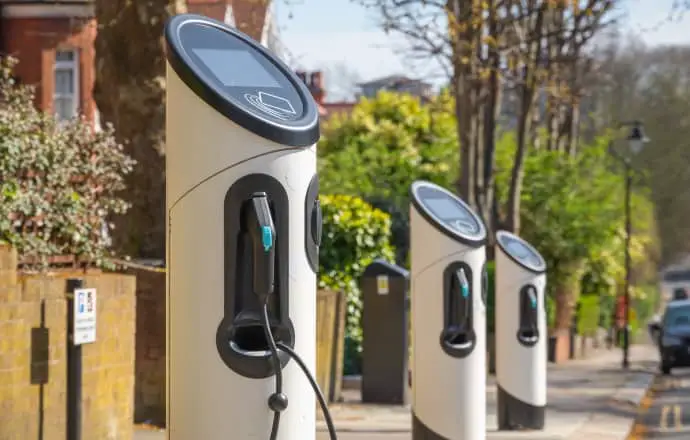
The government has set a target of 2035 for all new vehicle sales to be fully zero emission. However, according to the National Housing Survey, over a third of UK homes have no garage or driveway. That means nearly a third of car owners do not have any off-street parking to use for plug-in charging. So far, the most attractive usage pattern for someone using an electric vehicle (EV) every day is to plug it in to a dedicated home charger and charge it overnight using their domestic supply. This is how the cheapest rates of electricity can be accessed. However, it’s only an option for people who have a driveway or garage, and are in a position to install a custom charger, which may be a problem for people renting, for example. If the government’s target is to be met, there must be viable options for people who have to park their car on the street and simply cannot charge at home. So, what are the options?
On-Street Charging
The most obvious option is to find an on-street charging point somewhere near home. An increasingly high number of these are being installed by local councils, incentivised with government grants designed to provide the charging infrastructure needed to meet the 2035 target. Most public chargers are fast chargers, which are quicker than charging a car off a domestic supply, but more expensive. There are also quite a few rapid chargers – faster again than fast chargers but with a higher cost. The actual time it takes to charge up a battery depends on the make and model of the vehicle and the power of the charger. Not all vehicles are compatible with rapid chargers, either. So it’s worth doing some research in advance to check out nearby charging points and find out what the costs and timings would be.
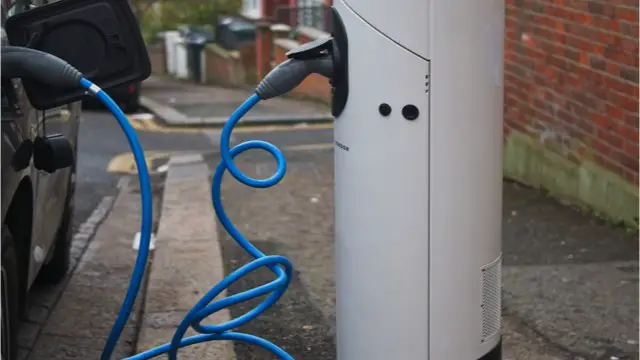
Zap-Map is a good place to start, as it provides a comprehensive mapping of charging points across the country. It also gives information about the type of charging point and payment options, including if there is a penalty for staying in the space for too long (a useful measure to prevent drivers hogging the space). It even has the option of leaving comments, so drivers can report any problems they’ve had with a particular charging point such as cable theft.
Polar, now known as bp pulse, is one of the country’s biggest networks. As an example from its network, detailed by drive-electric, a Kia-E Nero, the latest models of which have a range of well over 200 miles, would take 77 minutes to charge at a 50kWh charger, costing £16. At a rapid charge point of 150kWh, this would only take 25 minutes but cost £22.40. While both these costs are more than charging at home would be, they are both considerably cheaper than filling a tank with petrol or diesel. Further savings can also be had by becoming a member of one of the various charging networks. Again, research is needed to see which one is the best depending on location and likely routes, and Zap-Map is a great place to start.
Councils are increasingly looking at creative solutions such as using lamp posts, a cost-effective way of providing on-street chargers. Bear in mind that the space next to the charge point is not necessarily reserved for an EV, though councils could be lobbied to do this. In some places, EV owners have been successful in having the space outside their home earmarked for electric vehicle charging with a kerbside home charger.
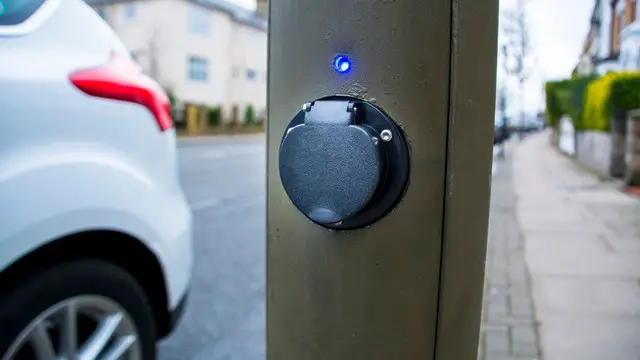
It may be worth approaching the council with a specific request for on-street charging. Through the Office for Low Emission Vehicles (OLEV), councils can access funding specifically to provide charging facilities for flats and terraced houses that should cover 75% of the cost, leaving them to find only the other 25%. This so far has been under-used by councils, perhaps because they are suffering from budgetary pressures elsewhere, but requests from residents might influence this.
Trailing A Cable Across the Pavement
Some EV drivers park outside the house and top up by trailing an electric cable from the house across to the car. The public pavement belongs to whoever manages the local highway, so it’s worth checking out what the attitude of your local authority is to this. Some councils, such as Hampshire County Council, are supportive, but others do not recommend it. There are also various issues to consider before resorting to this option, such as minimising the likelihood of someone tripping on the cable, ensuring the lead is the right type, managing if you can’t park outside your home, and so on. As the take-up of EVs continues to grow, trailing cables seem less and less likely to be the default solution, as that would result in a lot of cables!

Workplace Charging
An important option for commuters to consider is whether their vehicle could be charged at the workplace. Employers are being incentivised by the government to provide electric charging for their employees. This is normally offered for free, and is a great option for anyone regularly driving to work as you can simply charge during the day while parked at work. The aim is that half of all workplaces with car parks should have electric charging available by 2022, and if your employer hasn’t done it yet, consider asking them about it because government grants should make it attractive.
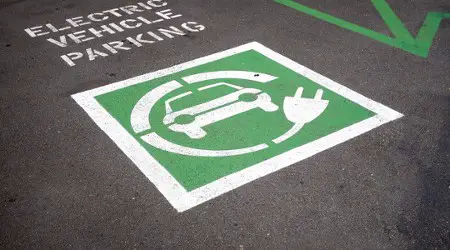
Car Parks
Supermarkets, leisure centres, shopping centres and train stations are some of the so-called “destinations” that are increasingly likely to offer car park charging. Zap-Map again is the place to go to track what’s available, and their list of destinations now includes airports, hotels, hospitals and attractions. Not only is charging while the car is parked very time-efficient, the chargers found in these places can often be used for free. For example, Tesco is in the midst of rolling out charging points at 400 of its Extra and Superstore locations. Most of these are fast chargers and free, but some are rapid and there is a charge (though again it’s less than filling up with conventional fuel). With the improvements in battery range that we’re seeing at the moment, it may be that a couple of fast charges per week in locations like these would be enough to keep you going – which means the model of having to charge overnight every night does not necessarily apply any more.
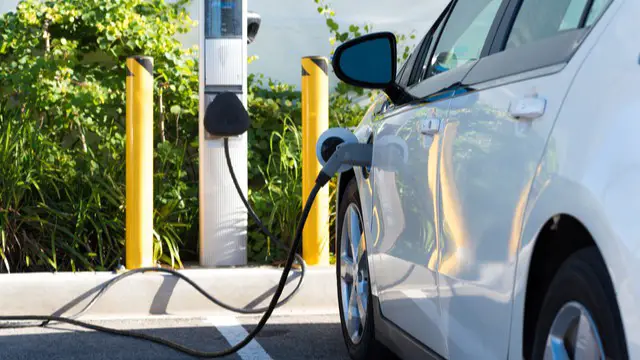
Railway stations are also providing charge points, with Great Western offering ChargePoint Genie points in car parks at four of its stations, and South Western Railway offering sixty car park chargers at six of its larger stations, initially free of charge for passengers. So if your commute involves driving to the train station, this could be the solution for you.
Charger Sharing
Rollout predictions are that there will always be more home chargers than any other sort, and none of them will be in use 24 hours a day. There are now options for people with off-street charging to offer their space to others in exchange for a fee. This is worth exploring, since if a nearby neighbour is happy to loan out their driveway within certain hours of the day, it could be very mutually convenient. Prices, availability, charger type and so on are all detailed on sites such as Co Charger.
Conclusion
The generally-accepted model of charging an EV overnight on the domestic supply clearly won’t work for the millions of car owners who don’t have a driveway or garage. But it’s worth bearing in mind that the range of EVs is increasing all the time, which means that for many people it won’t be necessary to charge every day. With a range of 250 miles or more, it might be sufficient for many owners to charge once a week or even less. The Covid pandemic is also resulting in a lot of people reconsidering whether commuting every day to an office is really necessary, and we might be moving towards a higher proportion of home working even when activities are back to normal. With that in mind, destination charging, where it can be part of a regular trip to the supermarket or gym, for example, starts to sound very feasible, especially if the electricity is free!
With the huge increase in on-street charging as well, driven by the government’s ambitious 2035 target, EV ownership for people without off-street parking is extremely feasible and is set to become even easier.

